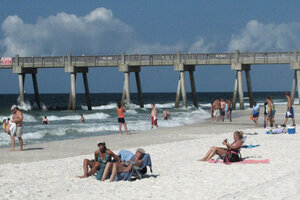Gooey tar balls seen near Pensacola Beach on Florida's Gulf coast
Tar balls have been seen near Pensacola Beach, Florida as the BP Gulf oil spill continues a month and a half after the Deepwater Horizon well explosion.

Beachgoers relax and walk on Pensacola Beach, Fla. Friday morning June 4, 2010. Waves of gooey tar blobs were washing ashore in growing numbers on the white sand of the Florida Panhandle Friday as a slick from the BP spill drifted closer to shore.
AP Photo/Melissa Nelson
Gulf Islands National Seashore, Florida
Waves of gooey tar blobs washed ashore in growing numbers on the white sand of the Florida Panhandle on Friday as a slick from the BP spill drifted closer to shore.
Spotters who had been seeing a few tar balls in recent days found a substantially larger number starting before dawn on the beaches of the Gulf Islands National Seashore and nearby areas. The park is a long string of connected barrier islands near Pensacola.
Keith Wilkins from Escambia County emergency management said tar patties were pretty thick on parts of the beach, as much as one every foot.
IN PICTURES: Sticky mess: The Gulf oil spill's impact on nature
Officials have said it is inevitable oil will eventually wash up on Panhandle beaches after a slick from the Deepwater Horizon spill was spotted about 9 miles offshore this week. The edge of the spill had moved to four miles off the coast Thursday, Gov. Charlie Crist said after a flyover.
Crist said the news of Friday's growth in tar balls was "very disturbing."
"Obviously, it's not the kind of news that we want to hear," Crist said on CNN's "American Morning."
Escambia County emergency officials has been preparing for the oil by shoring up miles of boom. The county plans to block oil from reaching inland waterways, but left its beaches unprotected because they are too difficult to shield and easier to clean up.
Watching the oil wash ashore on Pensacola Beach left tourists and residents saddened. The sign leading to the sand boasts "The World's Whitest Beaches," but they wondered how long that claim could be made. The Panhandle's beaches draw thousands of tourists each summer, bringing millions of dollars to the region.
David Lucas from Jonesville, La., and a group of friends waded into the oily water then quickly decided to continue their drive to Orlando.
"It was sticky brown globs out there," Lucas said as the group cleaned the mess off their feet.
Henry Fairleigh, 11, collected the half-dollar sized globs of tar into his child's sand shovel as he ran in out of the ocean waves. His father, Joe Fairleigh, said the family had been coming to Pensacola from their Louisville, Ky., home for years and was heartbroken.
"It's devastating to think how massive the ocean is and that it hasn't broken it up," he said.
Nearby, longtime beach resident Dawn Leight walked carrying two glass fish bowls in her hands to collect the sugary white sands.
"I'm being very sentimental. I want to save some of this white sand. I know it doesn't make any sense," she said.
Further east in Santa Rosa County, Gordon Goodin, chairman of the county Commission, said he saw gooey tar balls, "like the consistency of petroleum jelly" on Navarre Beach. The largest of the tar balls were about the size of a half-dollar coin, others were smaller than a dime.
"It's an inconvenience and yeah I'm mad about it, and it could be a lot worse," Goodin said. "But our neighbors to the west are getting it a lot worse."
Goodin said he remained hopeful that the worst of the spill would not hit the area.
"I'm may be the eternal optimist here, but I'm hoping the more this oil becomes weatherized, the less impact we (will) have on our beaches," Goodin said.
IN PICTURES: Sticky mess: The Gulf oil spill's impact on nature
